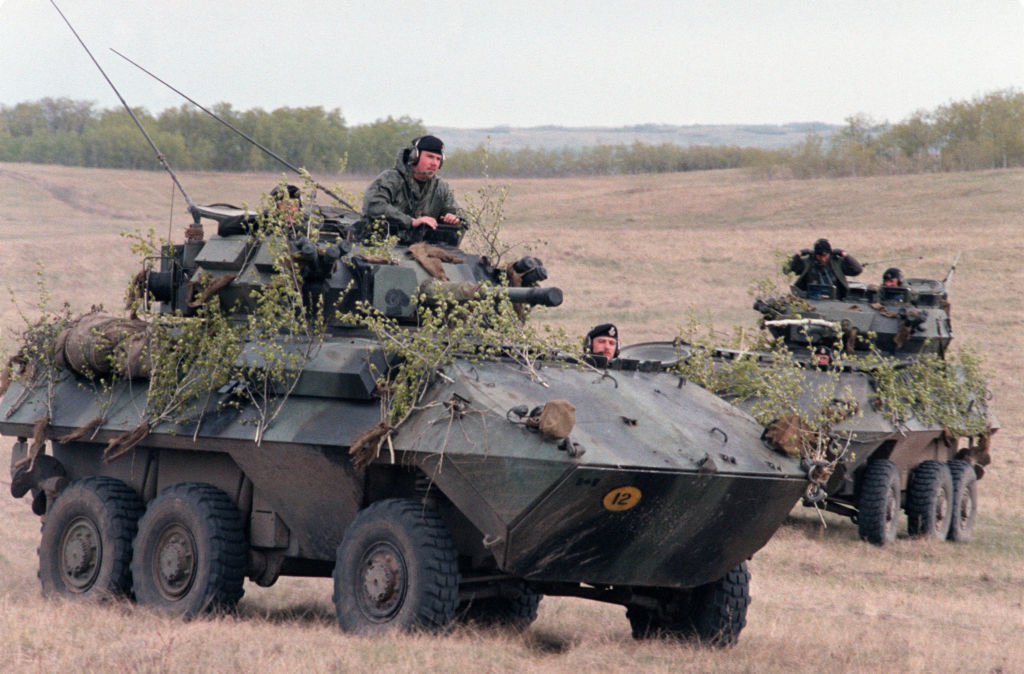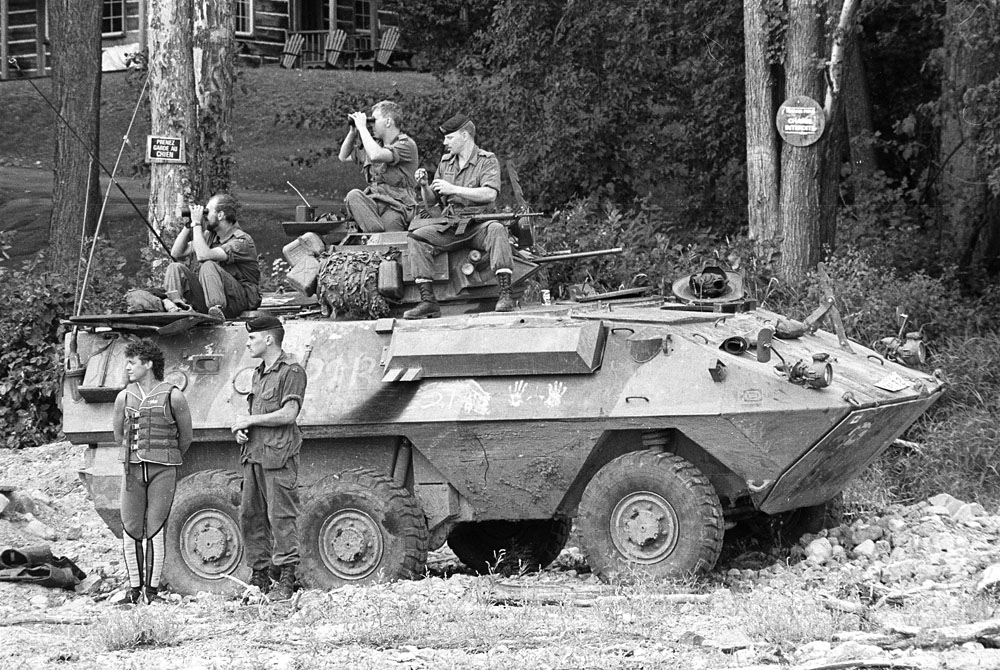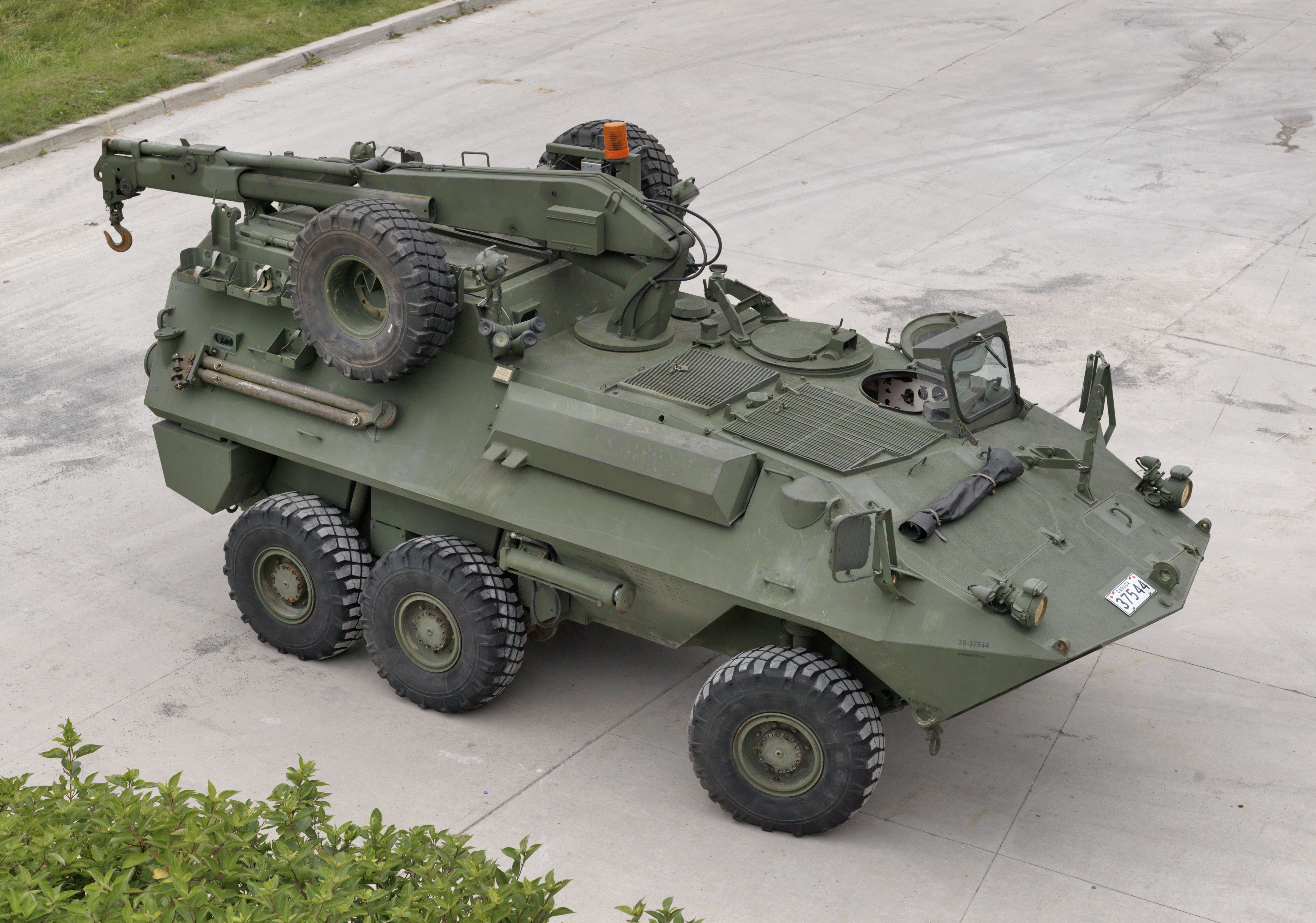The Armoured Vehicle General Purpose was a series of armoured fighting vehicles in service with the Canadian Army from 1978 to 2005. All three versions — Cougar, Grizzly and Husky — used a common hull based on the six-wheeled Swiss MOWAG Piranha 1. The main difference was the turret, or lack thereof. All versions were equipped with propellers and could swim. When production was completed in 1982, 491 vehicles had been built.
Background
In 1973, a competition began to select a new series of wheeled armoured vehicles known as the Armoured Vehicle General Purpose (AVGP). The vehicles were meant for military units based in Canada and not those which were overseas. Originally, the army intended to procure four AVGP variants: a tank trainer or Direct Fire Support Vehicle, an armoured personnel carrier (APC), an anti-tank missile version and an engineer vehicle.
Six vehicles entered the competition and, in 1977, the government selected the MOWAG Piranha. It had performed the best in field trials. More importantly, MOWAG was the only firm offering licenced production in Canada. MOWAG chose General Motors Diesel Division (now General Dynamics Land Systems — Canada) in London, Ontario, as its Canadian licensee, based on the company’s experience in manufacturing large vehicles.
Variants
In the end, the anti-tank missile and engineer versions were not developed. Only the armoured (Cougar), infantry (Grizzly), and maintenance and recovery (Husky) vehicles were produced.
The hull was common to all versions. Armour thickness varied between 10 to 13 mm at the front and between 6 to 8 mm on the sides ― enough to provide protection against 7.62 mm ammunition and artillery shell splinters. The driver sat in front, to the left of the engine.
General Motors replaced the Piranha’s original gasoline engine with a Detroit Diesel turbo-charged six-cylinder engine developing 275 horsepower. The engine drove the vehicle’s six wheels with an automatic transmission. All models weighed around 10.5 tonnes and could reach speeds of 100 km/h on roads with a range of 600 km. However, cross-country mobility was not as good as with tracked vehicles, particularly in very wet and muddy terrain. The AVGP hull was 5.97 m long and 2.53 m wide, with a height to hull roof of 1.85 m.
Originally, the AVGP series was equipped with propellers and trim vanes for swimming at a maximum speed of 10 km/h. The marine drives were later removed because of the cost of maintaining them. All versions also had two banks of four 66 mm smoke grenade dischargers for self-screening.
Cougar
The Cougar was the variant for armoured units. With a height of 2.62 m, the vehicle mounted a British Scorpion turret with a 76 mm gun and a coaxial 7.62 mm C6 machine gun. The low-velocity main armament could fire high explosive squash head, canister anti-personnel and smoke ammunition but could not fire a high-velocity armour-piercing round. Forty 76 mm rounds were carried, 10 of them in a ready rack. The vehicle also had 3,000 C6 rounds.

The Cougar carried a crew commander and gunner in a powered turret. The commander sat on the left with the gunner on the right. A disadvantage of the two-person turret was that the crew commander also loaded the main armament and cleared any stoppages on the coaxial machine gun.
Although there was room for two additional soldiers in the rear of the Cougar, this space was normally used for personal kit stowage. An infantry-tank telephone was installed on the outside rear of the vehicle so dismounted infantry could speak directly with the crew commander.
In the end, 195 Cougars were produced.
Grizzly
The Grizzly was the infantry APC version. It incorporated a Cadillac-Gage one-person turret with a.50-calibre heavy machine gun (HMG) and a 7.62 mm C6 machine gun. Grizzly’s height was 2.53 m.
The vehicle carried 1,000 HMG rounds and 4,400 C6 rounds. The Grizzly had a crew of three: a commander, a gunner and a driver. It also carried a small infantry section of up to six soldiers.

The infantry section was seated in the hull, on back-to-back outward-facing benches. Glass vision ports enabled the soldiers to see outside. Egress for the section was through a pair of rear doors or through roof hatches.
General Motors produced 269 Grizzlies.
Husky
The Husky maintenance and recovery vehicle did not have a turret. It mounted a winch and hydraulic crane and carried a 7.62 mm C6 machine gun in a pintle mount. Husky’s height was 2.69 m.

It had a crew of three: vehicle commander, driver and technician.
General Motors produced 27 Huskies.
Service
The Cougar was issued to Canada-based regular force armoured regiments as well as to armour and vehicle technician schools. A troop of four Cougars was also provided to selected Army Reserve armoured regiments, with others being stationed centrally at reserve training centres. This marked the first time regular and reserve armoured regiments used the same vehicle concurrently. In 2000, all Cougars were transferred to the reserves. (See Reserve Force of Canada.)
Regular force infantry battalions that did not have the M113 APC used the Grizzly. Selected Army Reserve infantry battalions as well as the infantry and vehicle technician schools also had the Grizzly.
The Husky maintenance and recovery vehicle was provided to all regular force AVGP-equipped armoured and infantry units, as well as to armour, infantry and vehicle technician schools.
A planned Life Extension Programme for some Grizzlies and Huskies only occurred for the recovery vehicles.
Operations
Although Cougars were originally intended only for tank training in Canada, they were deployed on some peacekeeping and peace support operations. Cougars were used in Somalia (1992–93), while Cougars and Grizzlies deployed to the former Yugoslavia (1992–95). In Yugoslavia, Cougars were reconfigured into seven-vehicle reconnaissance troops, rather than four-vehicle tank ones. (See Canadian Peacekeepers in the Balkans.)
Between 2005 and 2009, Canada loaned 100 Grizzlies and 5 Huskies to the African Union and United Nations missions in Sudan. The vehicles were operated by African crews.
In 2008, Uruguay purchased 44 Cougars and removed their turrets for use as APCs. The next year, Uruguay bought the vehicles loaned to the African Union and modernized them. In 2010, the Department of National Defence donated two disarmed Cougars to the RCMP. Additionally, three AVGPs were given to municipal police forces.
Today, several AVGPs can be found across Canada in military museums, outside armouries and as “gate guards” at entrances to army bases.

 Share on Facebook
Share on Facebook Share on X
Share on X Share by Email
Share by Email Share on Google Classroom
Share on Google Classroom


